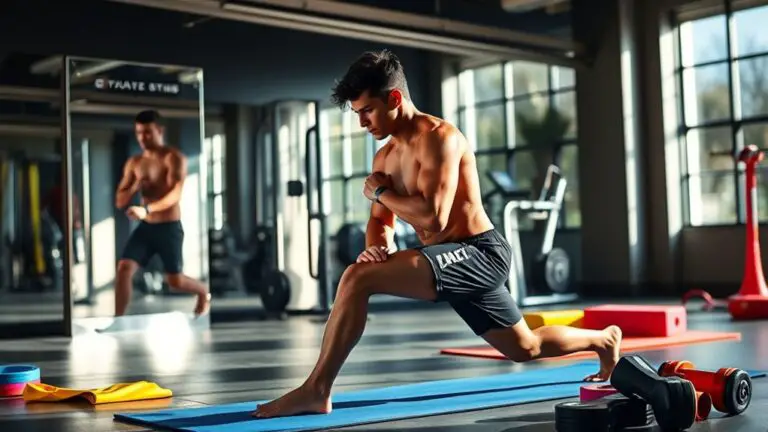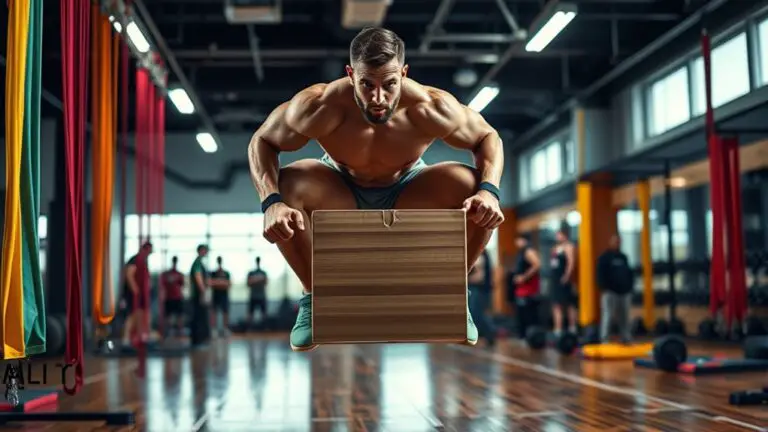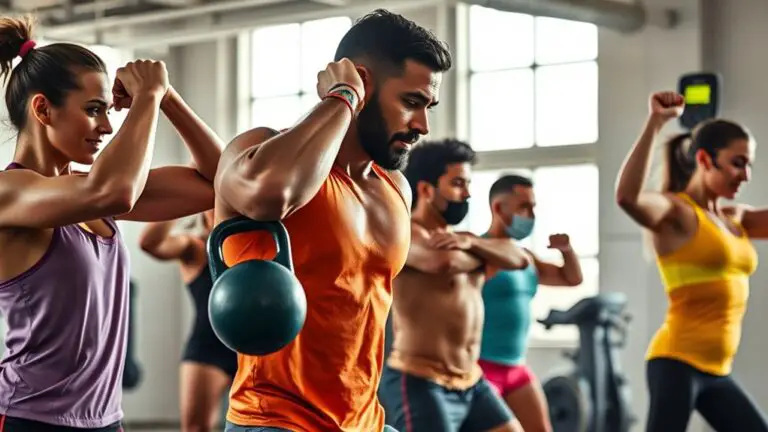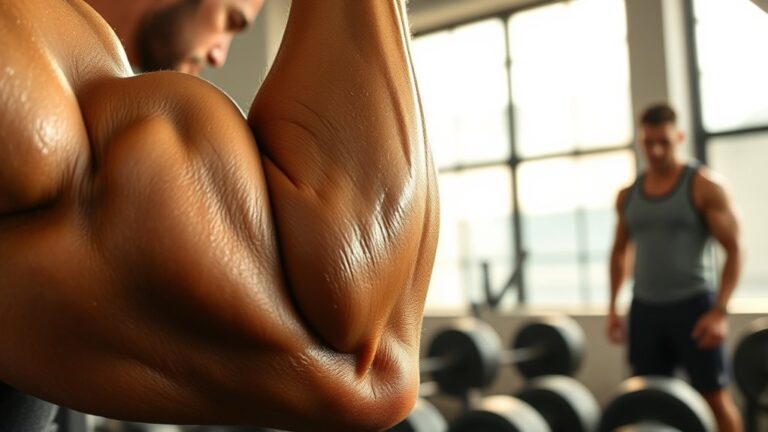How Gym Training Enhances Flexibility for Gymnasts
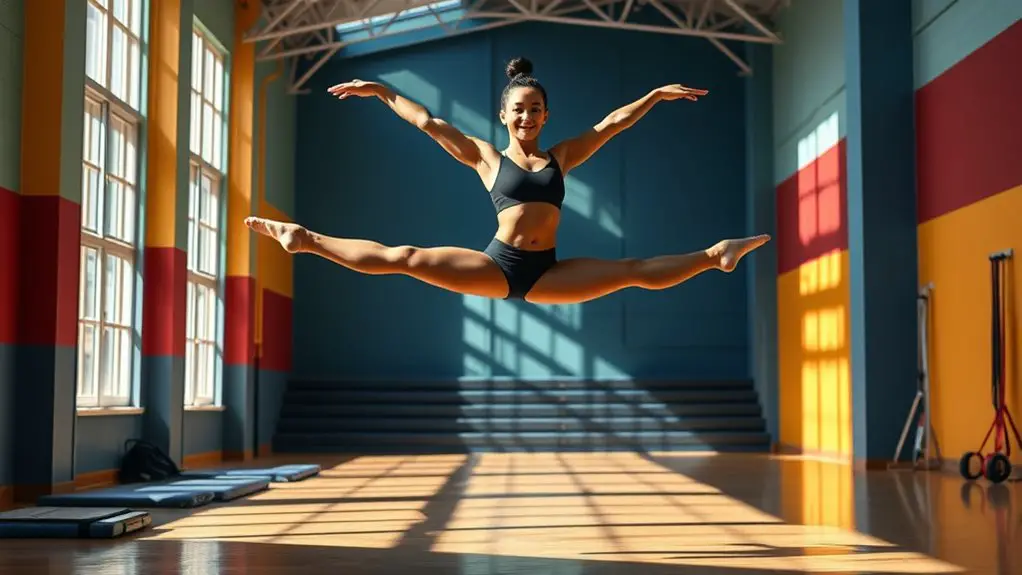
Gym training enhances flexibility for gymnasts by incorporating targeted approaches like dynamic and static stretching. These techniques prepare your muscles for intense routines, improve range of motion, and help prevent injuries. Additionally, strength training stabilizes your muscles, further contributing to flexibility. Warm-ups, including mobility drills, increase blood flow, making your muscles more pliable. Incorporating practices like Pilates and yoga can also support your flexibility goals. There’s more to uncover about optimizing your training for success.
The Importance of Flexibility in Gymnastics
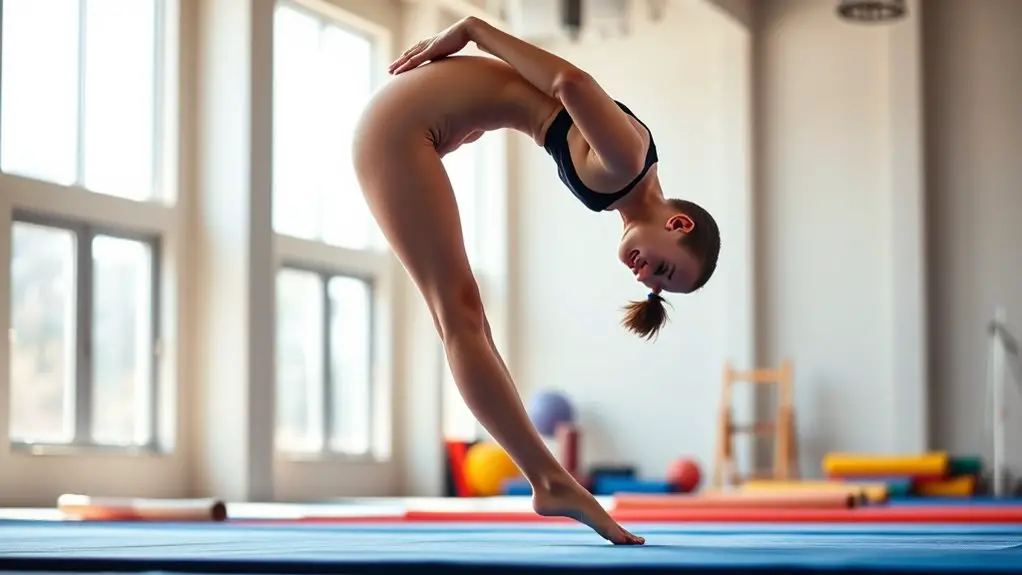
Flexibility is essential in gymnastics, as it not only enhances your performance but also helps prevent injuries. When you’re flexible, your body can move more freely, allowing you to execute complex routines with greater ease and precision. You’ll find that flexibility benefits your balance and coordination, making those challenging maneuvers feel more attainable.
However, there are some flexibility misconceptions you should be aware of. Many believe that you need to be incredibly flexible to start gymnastics, but that’s not true. Flexibility can be developed over time with consistent training, so don’t feel discouraged if you’re not at the level you want to be initially. Prioritizing safe stretching techniques and listening to your body will help you progress without risking injury. Embrace the journey; building flexibility will not only improve your skills but also keep you safe as you grow in the sport.
Key Components of Flexibility Training
To effectively improve your flexibility, it’s important to focus on several key components of flexibility training. Start by incorporating a flexibility assessment to identify your current range of motion. This helps tailor your routine to your specific needs.
Next, prioritize active recovery techniques, allowing your muscles to relax and lengthen without overexertion. Consistency is essential, so aim for regular practice to see gradual improvements.
Here’s a simple overview of key components:
| Component | Description |
|---|---|
| Flexibility Assessment | Evaluate your current flexibility levels |
| Active Recovery Techniques | Gentle movements to enhance recovery |
| Consistent Practice | Regular stretching sessions for improvement |
| Goal Setting | Set achievable flexibility goals |
Dynamic Stretching Techniques for Gymnasts
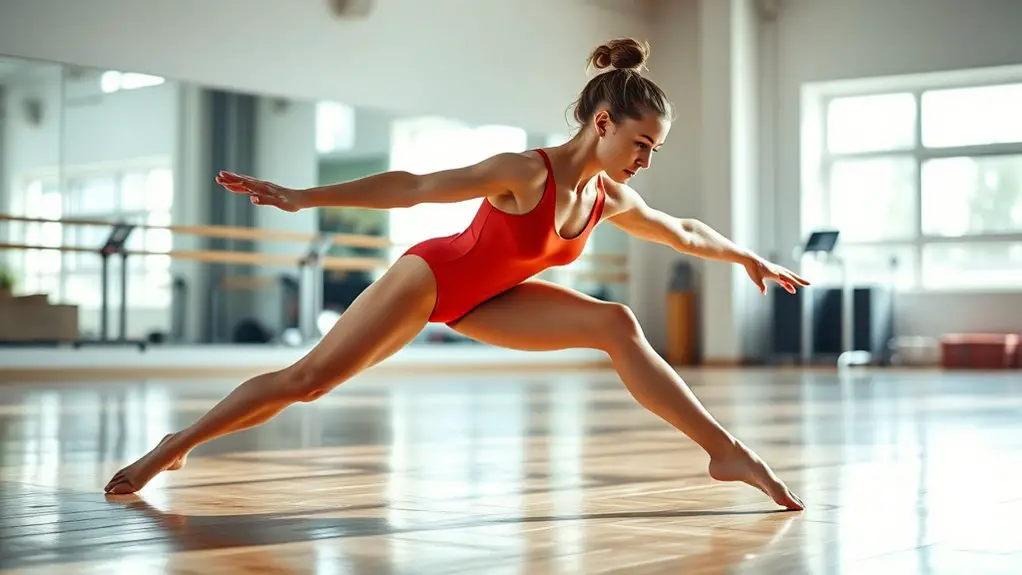
Dynamic stretching is essential for gymnasts, as it prepares your muscles for the intense movements ahead. You’ll want to focus on effective stretching drills that enhance your flexibility and performance. Timing and frequency also play a key role in maximizing your results, so let’s explore how to incorporate these elements into your training.
Importance of Dynamic Stretching
Incorporating dynamic stretching into your warm-up routine is essential for gymnasts of all levels. This form of active stretching helps improve your dynamic flexibility, which is vital for executing skills safely and effectively. Dynamic stretches prepare your muscles and joints for the movements you’ll perform, reducing the risk of injury. By engaging in controlled, rhythmic motions, you increase blood flow and activate the muscles you’ll rely on during your training. It’s important to remember that dynamic stretching should be done at a moderate pace to avoid overstretching. Focus on movements that mimic the actions you’ll encounter in gymnastics, ensuring your body’s ready for the demands ahead. Prioritizing this warm-up can greatly enhance your performance while keeping safety at the forefront.
Effective Stretching Drills
After establishing a solid warm-up with dynamic stretching, it’s time to focus on specific drills that can enhance your flexibility and overall performance. Incorporate stretching routines like leg swings and arm circles to target key muscle groups. These dynamic movements not only improve range of motion but also help you meet your flexibility benchmarks. Remember to maintain control throughout each drill to prevent injury. Another effective drill is the inchworm; it engages multiple muscles while promoting core stability. As you progress, listen to your body and adjust the intensity of each routine to guarantee safety. Consistent practice of these drills will lead to noticeable improvements in your flexibility, allowing you to perform at your best in the gym.
Timing and Frequency
Timing and frequency play an important role in the effectiveness of dynamic stretching techniques for gymnasts. To guarantee safety and maximize benefits, you’ll want to follow specific timing strategies. Incorporating dynamic stretches right before training or performances helps prepare your muscles for activity. Aim for a session lasting about 10 to 15 minutes, focusing on movements that mimic your routines.
As for frequency guidelines, practice dynamic stretching at least three to five times a week, adjusting based on your training intensity. Listening to your body is important; if you feel tightness or discomfort, consider modifying your routine. Consistent timing and proper frequency not only enhance flexibility but also reduce the risk of injury, keeping you safe while you train.
Static Stretching: When and How to Incorporate It
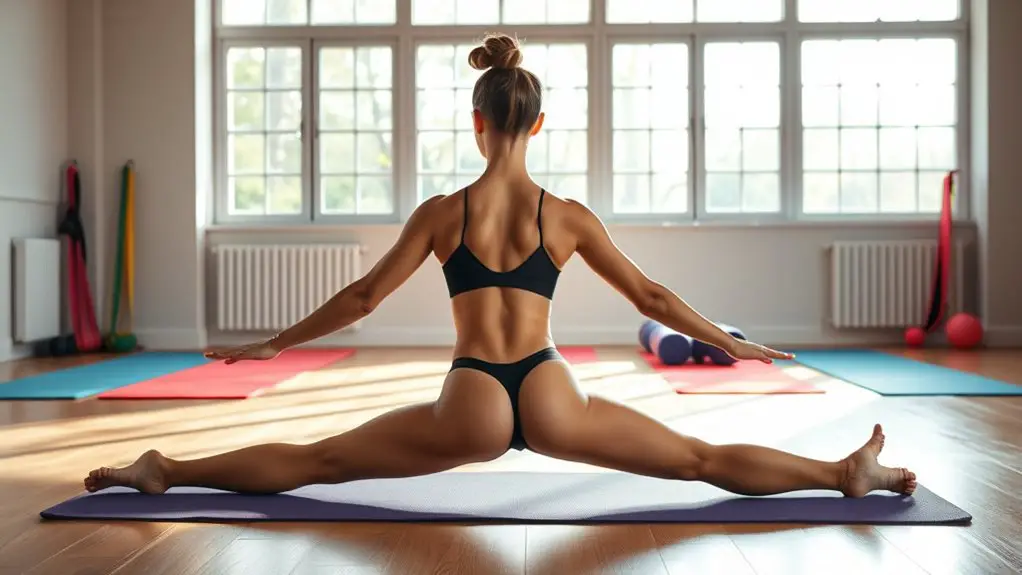
Although static stretching is often overlooked, it plays an essential role in a gymnast’s training routine. Incorporating static stretching techniques can enhance flexibility, increase range of motion, and reduce the risk of injury. It’s best to perform these stretches after your workouts when your muscles are warm and more pliable. This is when you’ll reap the most static stretching benefits.
To start, focus on major muscle groups used in gymnastics, like the hamstrings, hip flexors, and shoulders. Hold each stretch for 15-30 seconds without bouncing, ensuring you’re breathing deeply and relaxing into the stretch. Pay attention to how your body feels; if you experience pain, ease off. You can incorporate static stretching into your routine two to three times a week for ideal results. By prioritizing safety and listening to your body, you’ll not only enhance your flexibility but also support your overall performance as a gymnast.
Strength Training for Improved Flexibility
While many people think of strength training as purely a means to build muscle, it can also greatly enhance flexibility for gymnasts. By incorporating strength training into your routine, you can improve the stability and control of your muscles, which directly contributes to greater range of motion. This means your body can perform more complex movements safely and effectively.
Focus on exercises that target both large and small muscle groups, as this will help balance your strength and flexibility benefits. For instance, squats and lunges strengthen the legs while also promoting hip flexibility. Remember to emphasize proper form to avoid injury; safety should always come first.
Additionally, integrating resistance bands or bodyweight exercises can facilitate a gradual increase in flexibility. So, don’t overlook strength training—it’s an essential piece of the puzzle for enhancing your flexibility and ensuring your performance in gymnastics is both powerful and graceful.
The Role of Warm-Ups in Flexibility Enhancement
When it comes to enhancing flexibility, warm-ups play an essential role. Incorporating dynamic stretching techniques can prepare your muscles for more intense movements, making your training more effective. Plus, timing and duration are key factors that can greatly impact your flexibility gains.
Importance of Dynamic Stretching
Dynamic stretching is essential for gymnasts, as it not only prepares the body for the physical demands of training but also enhances flexibility. Engaging in dynamic warm-ups helps increase blood flow and muscle temperature, reducing the risk of injury. Many people believe flexibility myths, thinking static stretches are sufficient before workouts. However, incorporating dynamic stretches is vital, as they actively engage the muscles and joints in movement patterns similar to your routines. This approach not only improves your range of motion but also enhances performance during gymnastics. By prioritizing dynamic stretching in your warm-ups, you’ll set a solid foundation for safer and more effective training sessions, allowing you to reach your flexibility goals while minimizing injury risks.
Techniques for Effective Warm-Ups
Effective warm-ups are essential for gymnasts aiming to enhance their flexibility and overall performance. Before diving into intense routines, you should prioritize active recovery to prepare your body. Start with light aerobic activities like jogging or jumping jacks to increase your heart rate and warm up your muscles. After that, incorporate mobility drills focusing on major joints such as the hips, shoulders, and ankles. Dynamic movements like leg swings and arm circles can greatly improve your range of motion. Remember, safety is key; listen to your body and avoid pushing past your limits. By making these warm-up techniques a regular part of your training, you’ll set a solid foundation for flexibility and performance.
Timing and Duration Matters
Although many gymnasts may underestimate the importance of timing and duration in their warm-up routines, these factors play an essential role in enhancing flexibility. Implementing effective timing strategies guarantees your body is adequately prepared for rigorous training. Start with dynamic stretches that elevate your heart rate, and gradually shift to static stretches. Adjusting the duration of each warm-up phase is equally vital; spending enough time on each stretch can greatly improve your flexibility. Aim for at least 10-15 minutes of warm-up to allow your muscles to loosen up safely. Remember, rushing through your routine can lead to injuries, so prioritize a well-timed and properly paced warm-up. This way, you’ll not only enhance flexibility but also protect yourself during training sessions.
Pilates and Yoga: Complementary Practices for Flexibility
Pilates and yoga, both renowned for enhancing flexibility, can greatly benefit gymnasts looking to improve their performance. Incorporating Pilates into your routine offers numerous Pilates benefits, such as core strength and muscle control, which support safe and effective stretching. The controlled movements help prevent injuries by promoting proper alignment and balance.
On the other hand, yoga techniques focus on breath control and mindfulness, allowing you to deepen your stretches safely. Poses like downward dog and pigeon can open up tight muscles and enhance your overall flexibility. Combining these practices creates a well-rounded approach to flexibility training, ensuring you’re not only gaining range of motion but also building strength and stability.
Assessing Flexibility Progress in Gymnasts
How can you effectively measure your flexibility progress as a gymnast? One of the best ways is through regular flexibility assessments. Start by establishing a baseline — document your range of motion in key areas like hips, shoulders, and back. Use simple tests, such as the sit-and-reach or splits, to gauge improvements.
To guarantee safety, always warm up before assessments and listen to your body. If you feel pain, ease off and reassess later. Progress tracking is essential; keep a journal or use apps to record your results over time. This way, you can see your advancements and identify areas needing more focus.
Incorporating these assessments into your routine not only helps you understand your flexibility journey but also boosts your confidence as you witness your improvements. Remember, consistency is key to achieving your flexibility goals safely!
Tips for Maintaining Flexibility During Off-Season Training
After evaluating your flexibility progress, it’s important to maintain those gains during the off-season. Here are some effective off-season strategies for flexibility maintenance:
| Activity | Frequency | Duration |
|---|---|---|
| Dynamic Stretching | 3-4 times/week | 10-15 mins |
| Static Stretching | 2-3 times/week | 20 mins |
| Yoga or Pilates | 1-2 times/week | 30-60 mins |
| Foam Rolling | After workouts | 5-10 mins |
Incorporating these activities will help keep your muscles limber and ready for the next season. Be sure to listen to your body and avoid pushing yourself too hard, as safety is key. Consistency is essential, so set a schedule that fits your lifestyle. Remember, maintaining flexibility is as critical as any other aspect of your training, ensuring you’re prepared for your next gymnastics challenge!
Frequently Asked Questions
How Long Does It Take to See Flexibility Improvements?
When you’re looking to improve your flexibility, it often takes a few weeks to start seeing noticeable changes. Generally, you might hit flexibility benchmarks within four to six weeks of consistent stretching and training. However, everyone’s body is different, so improvement timelines can vary. It’s essential to listen to your body and avoid pushing too hard to guarantee you’re training safely and effectively. Consistency and patience will yield the best results!
Can Flexibility Training Prevent Injuries in Gymnasts?
Did you know that over 50% of gymnastic injuries are related to flexibility issues? Incorporating flexibility training into your routine can greatly aid in injury prevention. By using specific training techniques, you’ll enhance your range of motion, reduce muscle stiffness, and improve overall body awareness. When your body is more flexible, you’re less likely to strain muscles or joints, making it essential for your safety and performance in gymnastics.
Are There Any Age Restrictions for Flexibility Training?
When it comes to flexibility training, there aren’t strict age restrictions, but age guidelines are important for safety. For younger athletes, youth training should focus on proper techniques and gradual progression to prevent injuries. You’re encouraged to start with basic stretches and build up as you develop strength and control. Always listen to your body and consult with a coach or expert to guarantee you’re practicing safely and effectively, regardless of your age.
How Often Should Gymnasts Practice Flexibility Exercises?
If you want to feel like a rubber band in no time, practicing flexibility exercises is key! You should aim for flexibility routines at least three to five times a week. Incorporate various stretching techniques to keep things fresh and effective. Just remember, safety first—listen to your body and don’t push yourself too hard. Gradually increase your intensity, and you’ll see improvements without risking injury. Flexibility takes time, but it’s worth it!
What Common Mistakes Do Gymnasts Make in Flexibility Training?
When it comes to flexibility training, you might find yourself making common mistakes that could lead to overstretching injuries. One major issue is skipping proper warm-ups, which are essential for preparing your muscles. If you dive straight into stretching, you increase the risk of strains or pulls. Always guarantee you’re warmed up beforehand, and listen to your body’s limits to avoid pushing yourself too far too quickly. Safety should always come first in your training.
